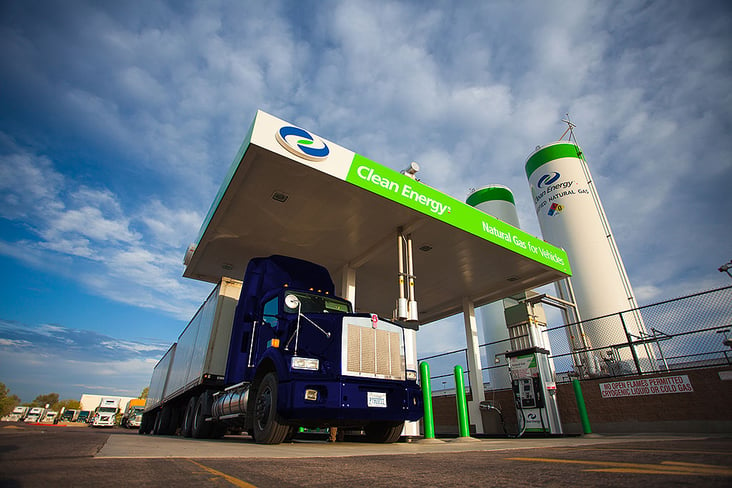This post is one in a series featuring the complete slate of advanced energy technologies outlined in the report This Is Advanced Energy.

Photo courtesy of Clean Energy Fuels.
Compressed Natural Gas (CNG) and Liquefied Natural Gas (LNG) are gaining market share as transportation fuels. The technologies for producing, storing and using both CNG and LNG are well developed. With CNG, pipeline natural gas is compressed to 3,000 to 4,000 pounds per square inch (psi) and stored in a pressurized tank on board the vehicle. CNG fueling stations include all the equipment necessary to take natural gas from the local distribution system, compress it, and refuel the vehicles. With LNG, the natural gas must be cooled to about -260°F at which point the methane (the main constituent of natural gas) turns to a liquid. The LNG is stored in insulated cryogenic tanks at the refueling station and on board the vehicle.
As of 2016, there are about 150,000 vehicles in the United States powered by natural gas, predominantly CNG vehicles, served by 723 private CNG stations and 819 public stations across the country. LNG takes more energy to produce than CNG but offers greater range as it has a higher volumetric energy density. As such it is mainly used for long-haul trucking, where trucks follow well-established routes. In this case, it is possible to serve a large number of trucks with a relatively small number of refueling stations (numbering a few hundred), There are currently 71 public LNG fueling stations across 25 states, including many along the I-35 corridor in Texas and along I-5 in California. The private sector has initiated this build-out, with nearly 70% of fueling stations, including both private and public stations, built by Clean Energy Fuels. Because LNG production is more energy intensive and complex than CNG production, LNG is typically produced at a few large-scale plants and delivered by truck to the refueling stations, as is done today with gasoline and diesel fuel.
Fuel cost is the main driver for considering a vehicle powered by CNG or LNG over gasoline or diesel. Since these fuels are consistently available at lower prices, the incremental cost of the vehicle and refueling equipment can be made back over time. The average retail fuel price for CNG in April 2015 was $2.09 per gasoline gallon equivalent (gge), lower than both gasoline ($2.42/gallon) and diesel ($2.56/gallon). Now that natural gas is relatively inexpensive and abundant, more fleet operators and consumers are considering switching to CNG
or LNG. This increases fuel diversity in the transportation sector, which benefits energy security and also brings added choices to the marketplace.
